The Lubrizol Corp.
Lubrizol Unlocks Hydraulic Efficiency with Durability
Shubhamita Basu PhD, North America Product Manager Industrial Oils, The Lubrizol Corporation | TLT CMF Plus November 2019
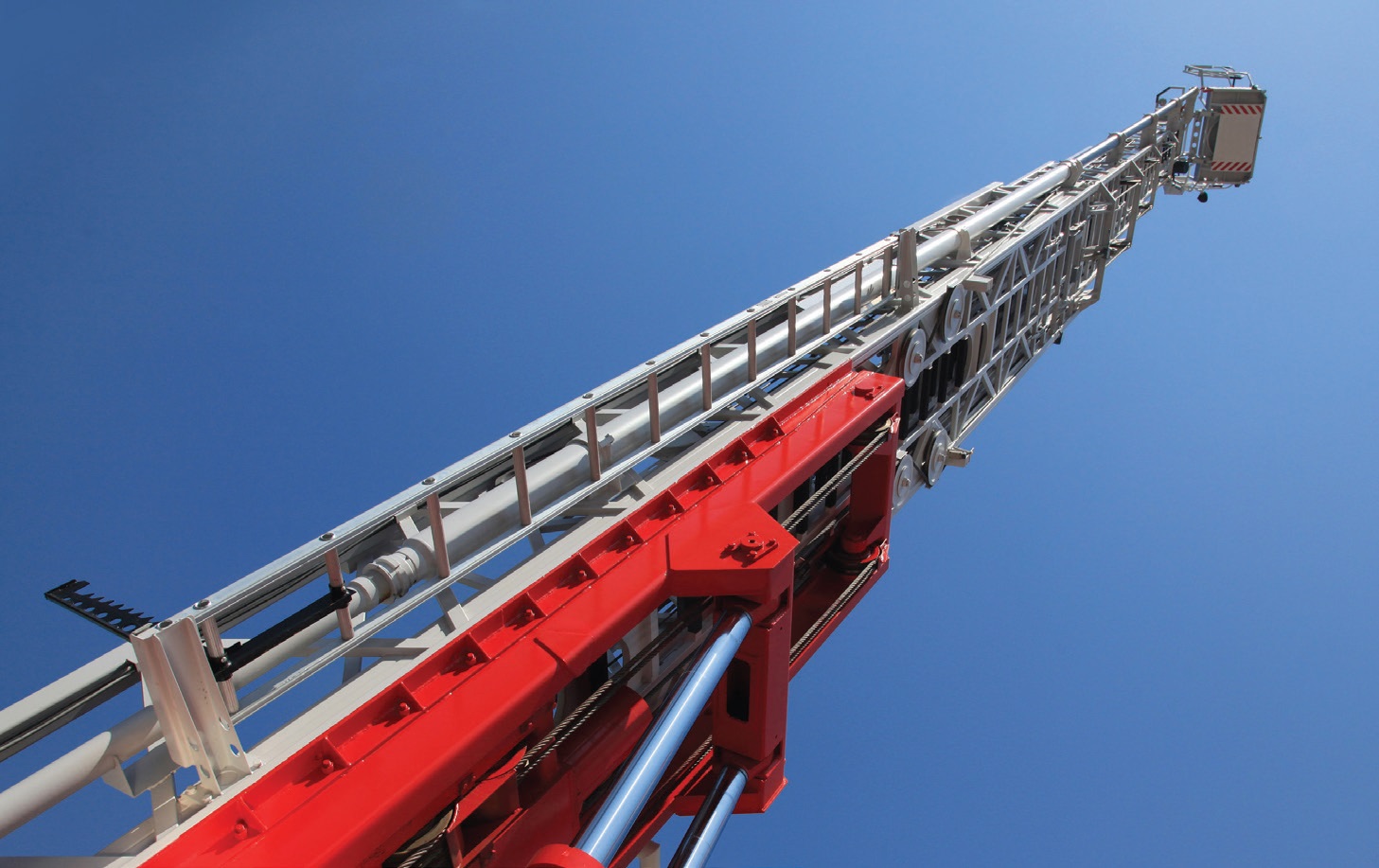
© Can Stock Photo / sspopov
Fluid power drives the world around us. From the mobile construction, mining, agriculture and forestry industries to all manner of stationary manufacturing, hydraulic power is there doing work. The hydraulic circuits carrying this power are continuously expected to provide higher throughput and deliver greater productivity. To move more earth, plant more crops, or manufacture more parts, hydraulic equipment is forced to operate under increasing stress and without unexpected failure.
The cost of unplanned downtime can be significant—service and repairs for one pump failure can reach $20,000. This figure doesn’t include productivity losses, costs of missed deadlines, or reputation damage. A case study on unplanned downtime in a gold mine showed a commodity value loss can be anywhere between $75,000 - $113,000 per hour, depending on the current gold price.
As the market trends towards more compact systems, increased productivity expectations, coupled with higher operating pressures and greater power densities, provide an opportunity for the lubricant to deliver enhanced efficiency performance while still critically protecting against unexpected downtime. Incorporating a hydraulic fluid that provides proven durability and reliability while increasing productivity can provide fuel or energy savings and reduce the overall total cost of ownership of equipment. End users need a fluid that can offer reliable performance, increase productivity and maintain uptime without compromising oil drain life.
Lubrizol’s Solution
Balancing durability and productivity is critical when designing an energy-efficient hydraulic fluid. The combination of Lubrizol® 5703 and Lucant™ in a high-quality base oil unlocks efficiency with durability.
The premium antiwear hydraulic additive package, Lubrizol 5703, has been tested extensively in the lab and offers proven, robust equipment protection in the most demanding operating conditions in the field. Lubrizol 5703 is formulated to deliver excellent antiwear protection with high thermal and oxidative stability, coupled with excellent hydrolytic stability and rust protection. This additive package has been approved by global hydraulic equipment leaders Bosch Rexroth, Denison, Eaton and others.
Lucant is a specially-developed performance polymer for multigrade hydraulic fluids. It offers many performance benefits over conventional viscosity modifiers including:
•
Excellent thickening efficiency for optimizing treat rate
•
Outstanding shear stability to keep your fluid in-grade
•
Low fluid traction to keep operating temperatures down
•
Reduced flow losses to save you fuel and money
Together with Lubrizol 5703, Lucant delivers lower total cost of ownership with durable, worry-free operation.
Performance Demonstration – Durability Testing
When developing hydraulic fluids, Lubrizol formulators run a gamut of bench and pump tests to ensure reliable field operation.
Pump Performance
Standardized pump tests recommended by leading hydraulic pump manufacturers are an important tool for evaluating hydraulic lubricants. The combination of Lubrizol 5703 and Lucant has been tested and approved by both Eaton and Denison. Lubrizol’s energy efficient solution provides excellent antiwear performance in the Eaton 35VQ pump test (
Figure 1).
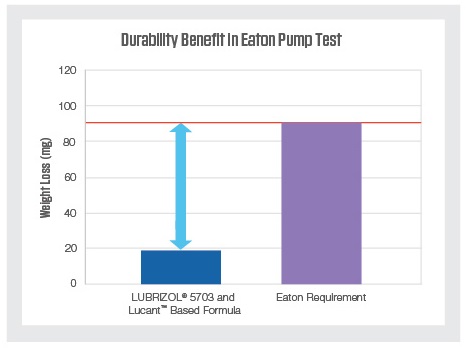 Figure 1: Performance in Eaton 35VQ Pump Test
Extended Shear Stability
Figure 1: Performance in Eaton 35VQ Pump Test
Extended Shear Stability
Shear stability testing is also recommended by pump manufacturers for multigrade hydraulic fluids to ensure that they can maintain viscosity and thick, part-protecting lubricant films. In the lab, fluids are often evaluated after 20 hours of bench shear testing, but in the field, multigrade fluids are subject to harsh environments for much longer intervals. Multigrade lubricants can continue to lose viscosity leading to thinner protective lubricant films, damaged parts, and downtime. Running longer shear stability tests can indicate the extended shear behavior of lubricants.
In addition to the standard 20-hour KRL shear stability test (CEC-L-45-A-99), Lubrizol scientists run extended, 200-hour, KRL shear testing and monitor the loss of kinematic viscosity at 100°C.
Figure 2 compares the percentage of viscosity loss of two fluids of equal starting viscosity grade. The first is Lubrizol’s energy efficient solution containing Lucant, while the second, is a conventional multigrade fluid. The fluid formulated with Lucant maintains its viscosity longer and remains within the 15% viscosity loss limit allowed by the OEMs, again affording equipment owners and operators peace of mind.
 Figure 2: 200 Hour KRL Shear Stability Test
Performance Demonstration – Efficiency Testing
Figure 2: 200 Hour KRL Shear Stability Test
Performance Demonstration – Efficiency Testing
For hydraulic equipment, efficiency in the field is measured by fuel consumption and/or time needed to perform work. In the lab, efficiency is calculated from test inputs, like torque and flow in a controlled system. Unlike the automotive industry, there is no standardized industry testing or specification to measure off-road hydraulic efficiency.
Total System Efficiency Testing Rig
In the absence of an industry standard test, Lubrizol has developed a total hydraulic system efficiency rig, consisting of a hydraulic pump and motor joined by conventional hydraulic hoses, lines and valves. This tool, unlike a simple pump test, can evaluate the efficiency of different lubricants in an entire hydraulic circuit and was designed to mimic real-world mobile hydraulic equipment. The efficiency results for Lubrizol’s energy efficient solution containing Lucant as compared to a monograde fluid are shown in
Figure 3. In this testing, Lucant provides significant improvement.
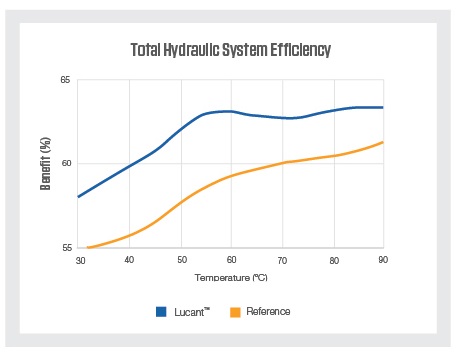 Figure 3: Performance in Total Hydraulic System Efficiency Test
Real-World Field Efficiency
Figure 3: Performance in Total Hydraulic System Efficiency Test
Real-World Field Efficiency
To compliment efficiency gains observed total system lab testing, a controlled field evaluation under real-world conditions was conducted on a backhoe loader equipped with sensors to measure pressure, temperature, flow and fuel usage. Fuel saving benefits were calculated for the same test fluids under a variety of duty cycles. Again, the Lucant-containing lubricant delivered efficiency gains over the monograde reference fluid (
Figure 4).
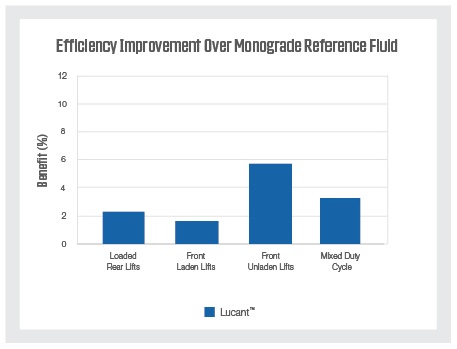 Figure 4: Performance in Field Test on a Backhoe Loader
Temperature Reduction in Hydraulic Applications
Figure 4: Performance in Field Test on a Backhoe Loader
Temperature Reduction in Hydraulic Applications
In addition to improving efficiency and durability, the combination of Lubrizol 5703 and Lucant can reduce operating temperatures of hydraulic fluid. The above testing in Lubrizol’s total system efficiency rig also revealed that the Lucant-based fluid can reduce the operating temperature by 3-4 °C compared to both the conventional multigrade and the monograde reference (
Figure 5, left). Thermal imaging of Eaton 20VQ testing also reveals a reduction in pump surface temperature (
Figure 5, right). With current equipment sump size trending smaller than before, fluids are expected to face hotter temperatures. Lucant can reduce fluid temperature, affording consistent hydraulic actuation and longer fluid life.
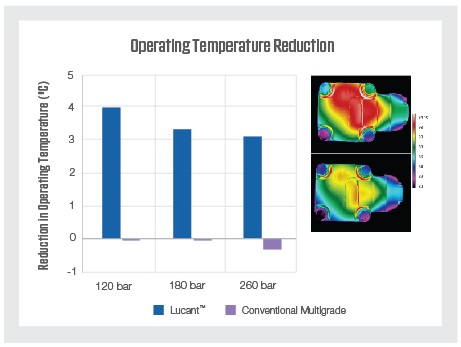 Figure 5: Reduction in Operating Temperature in a Hydraulic System
Lucant and Secondary Flow
Figure 5: Reduction in Operating Temperature in a Hydraulic System
Lucant and Secondary Flow
The efficiency, durability, and operating temperature data above speak volumes, but how does Lucant “work?”
Like all things hydraulic, the key lies in flow.
Hydraulic power is the product of flow and pressure. Increase flow and you can increase power. Hydraulic circuits, particularly in compact mobile equipment, inevitably contain a multitude of lines, twists, turns and valves, all there waiting to reduce flow. Some of this flow loss comes in the form of secondary flow. Any flow not in line with the main flow direction is secondary flow, and secondary flow effectively means lost power.
Figure 6 shows a model of the complex flow patterns a fluid experiences simply by going around a bend. The bright blue and red areas depict significant secondary flows. Lubrizol researchers developed a technique for measuring the severity of these parasitic flows using lasers, a high-speed camera, and reflective particles. Using this capability, it was observed that Lucant dramatically reduces secondary flow around 90° and 180° bends.
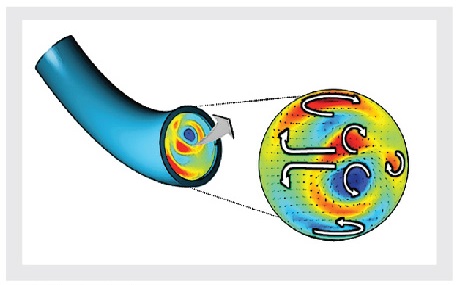 Figure 6: Secondary Flow Losses
Conclusion
Figure 6: Secondary Flow Losses
Conclusion
It is essential to balance durability and efficiency of a hydraulic fluid to maximize uptime and reduce total cost of ownership. Hydraulic fluids comprising Lubrizol 5703 and Lucant combine trusted durability performance with a measurable improvement in efficiency in both total system lab testing and real-world field evaluations. This energy-efficient formula maintains its viscosity longer in extended shear testing compared to a fluid formulated with other viscosity modifiers. This combination was observed to increase efficiency and reduce operating temperature in lab and field testing. Lastly, the Lucant-based formula increases efficiency by reducing secondary flow losses seen around bends in hydraulic lines and, together with Lubrizol 5703, helps unlock efficiency with durability.